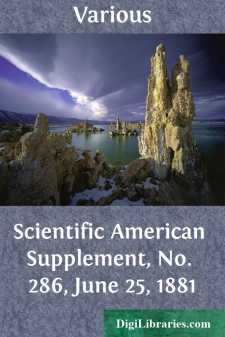Categories
- Antiques & Collectibles 13
- Architecture 36
- Art 48
- Bibles 22
- Biography & Autobiography 813
- Body, Mind & Spirit 142
- Business & Economics 28
- Children's Books 14
- Children's Fiction 11
- Computers 4
- Cooking 94
- Crafts & Hobbies 4
- Drama 346
- Education 46
- Family & Relationships 57
- Fiction 11828
- Games 19
- Gardening 17
- Health & Fitness 34
- History 1377
- House & Home 1
- Humor 147
- Juvenile Fiction 1873
- Juvenile Nonfiction 202
- Language Arts & Disciplines 88
- Law 16
- Literary Collections 686
- Literary Criticism 179
- Mathematics 13
- Medical 41
- Music 40
- Nature 179
- Non-Classifiable 1768
- Performing Arts 7
- Periodicals 1453
- Philosophy 64
- Photography 2
- Poetry 896
- Political Science 203
- Psychology 42
- Reference 154
- Religion 513
- Science 126
- Self-Help 84
- Social Science 81
- Sports & Recreation 34
- Study Aids 3
- Technology & Engineering 59
- Transportation 23
- Travel 463
- True Crime 29
Scientific American Supplement, No. 1082, September 26, 1896
by: Various
Categories:
Description:
Excerpt
ZANZIBAR.
The sudden death on August 25 of Sultan Hamid bin Thwain, the ruler of Zanzibar, the attempted usurpation by Seyyid Khalid, and the bombardment of the palace by the British warships, have directed public attention to this comparatively little known but important city on the east coast of Africa.
The Zanzibar dominions achieved their independence some forty years ago under Seyyid Majid, whose father was Seyyid Said, the Sultan of Muscat and Zanzibar. The dominions formerly extended from Warsheik south to Tanghi Bay. In 1890 the coast line from Ruvuma to Wanga, with the island of Mafia, was ceded to Germany, by which partition the country was reduced to two islands, Zanzibar and Pemba, containing about a thousand square miles with 165,000 inhabitants, a strip of coast line ten miles long, together with three smaller islands and five seaports. Zanzibar is a British protectorate, as are also the Zanzibar dominions on the mainland as far north as the mouth of the Juba. The remainder of the mainland dominions to the south are leased to an Italian company.
PALACE SQUARE, ZANZIBAR: TROOPS ASSEMBLED IN FRONT OF GOVERNMENT HOUSE; PALACE, WITH THE LATE SULTAN IN THE GALLERY, TO THE RIGHT HAND; HAREM TO THE LEFT.The island of Zanzibar, together with the neighboring islands of Pemba and Mafia, to the north and south, is generally of coral formation, with here and there hills of a reddish clay, which rise in the south to an elevation of 450 feet and in the north develop into a range of hills which runs parallel to the shore at a height of over 1,000 feet. The dense forests which originally covered the island have been cut down, and the soil, which is of unusual fertility, is under thorough cultivation, yielding heavy crops of corn and manioc, which latter forms the staple food of the people.
The soil and climate are specially suited to the clove, which is raised in great quantities, the crop forming four-fifths of the total clove crop of the world. The seaboard lying opposite the island of Zanzibar is level and swampy, and the many rivers which flow from the escarpment of the great inland plateau have brought down a vast deposit of rich alluvial matter, upon which, aided by the moist, warm climate, a dense growth of tropical vegetation flourishes. A native growth of this region is the copal tree, famous as yielding the best gum known to commerce. Rice, maize, millet, the cocoa nut and the oil palm are cultivated, and the whole country is well adapted to the raising of sugar, coffee, cotton, indigo, and the various spices.
Of the original races of the island of Zanzibar only a few representatives survive. These live on the east side, and are known as Wa-Hadimu Bantus. The main population is a strange mixture of "full blood and half-caste Arabs, Indian 'Canarians' (that is, half-caste Portuguese from Kanara on the Malabar coast of India), Swahili of every shade, slaves or freedmen from all parts of East Africa," with a small sprinkling of Americans and Europeans....












